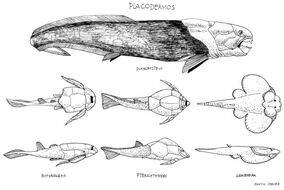
Placoderms are a group of vertebrates that evolved and went extinct in the Devonian period. They were the most successful group of animals in the Devonian period as well. They were usually small, around 1-2 metres or smaller; however, there were some massive ones. Dunkleosteus grew up to 9 metres (33 feet) long and was quite possible the biggest predator in the Devonian as well as being one of the largest predators of the Paleozoic! Titanichthys also grew to this size but it was a filter feeder and did not weigh as much but might have been the same length. Placoderms are the only group of vertebrates to go fully extinct because they did not have any relatives or similar animals.
Placoderms were usually very placid creatures eating detritus or planktonic organisms such is the case with Bothriolepis. However Dunkleosteus was a vicious macropredator capable of taking down nearly any animal in its wide vicinity. It was also the first vertebrate superpredator so in that way. Placoderms produced the first vertebrate apex predator in the form of this terrifying fish.